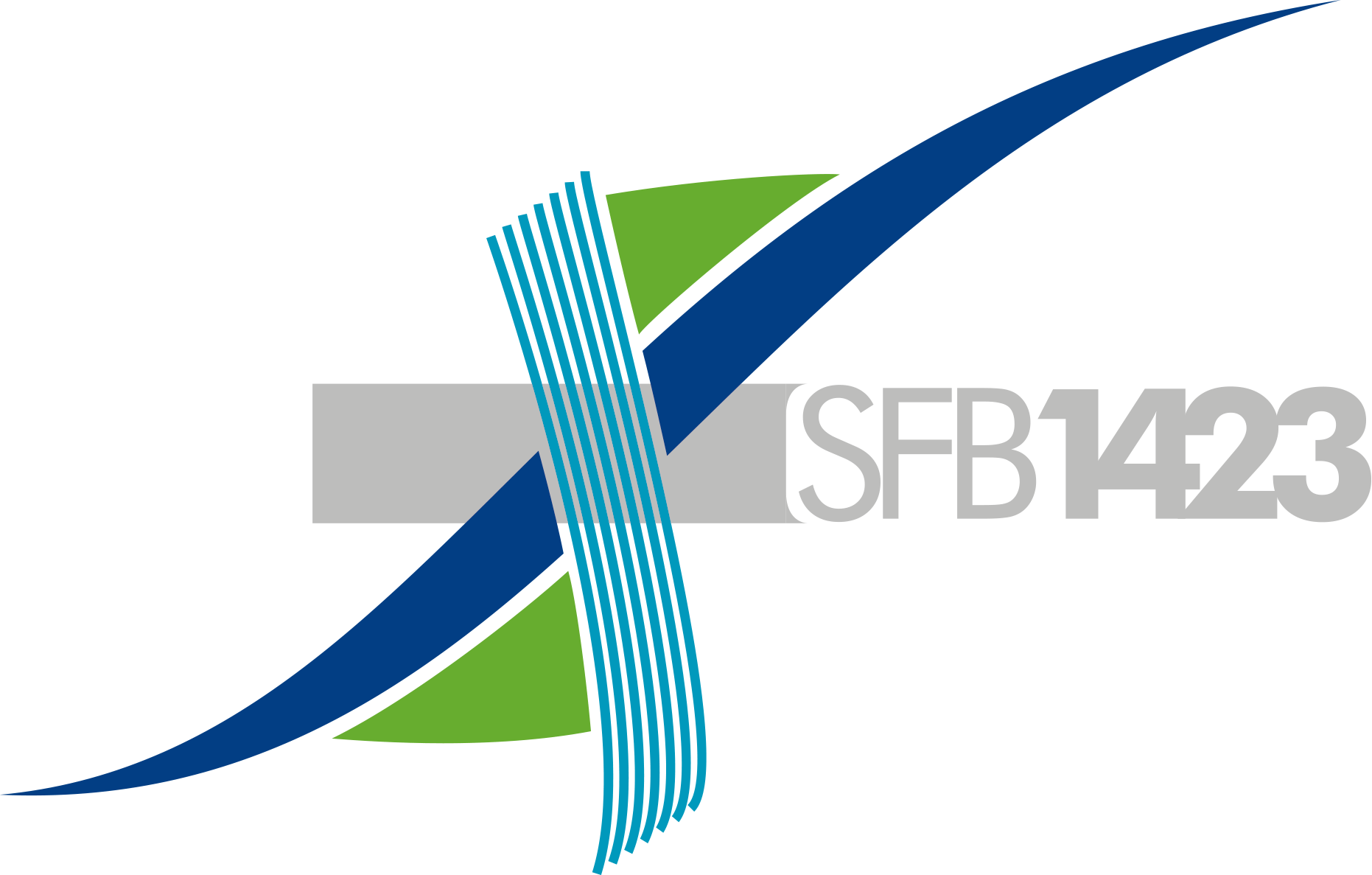

Project A06 – Enzymology of autoproteolysis and signaling function of the GAIN domain in adhesion GPCRs
The continued aim of this project is to understand the basis of the structural dynamics of the GAIN domain, the defining structural element of all adhesion GPCRs. We will focus on GAIN domain autoproteolytic activity, and release of the Stachel sequence for binding to the 7TM domain. Previous work led to the hypothesis that several GPS-distant elements of the GAIN domain impact self-cleavage, including the mostly conserved direct environment of the GPS motif, residues of the more flexible and diverse flap regions in at the domain’s surface, structural components of the 7TM domain, and molecules that assist with GAIN domain folding. We investigate each of these classes of contributing factors to aGPCR self-cleavage and Stachel release to obtain a deeper understanding of the unique role of the GAIN domain and its self-cleavage in aGPCR synthesis, trafficking and signaling.
Signal transduction via the GAIN (GPCR autoproteolysis inducing) domain is a unique property of adhesion G protein-coupled receptors (aGPCRs). We will systematically investigate the role of active site residues of the GAIN autoprotease on GPCR proteolysis site (GPS) cleavage by expression of the isolated domain, entire ectodomain and full-length aGPCR. These experiments will characterize the influence and role of active site residues, and the complex formed with other extracellular folds and the 7TM part on GAIN autoproteolytic activity. We will determine crystal structures of ectodomains in the pre-cleavage and post-cleavage states. Furthermore, we will investigate how the structure and dynamics of the GAIN domain influences the activation of aGPCRs by release of the Stachel peptide acting as a tethered agonist.
Contact

Prof. Dr. D.Phil. (Oxon) Tobias Langenhan (Project Leader)
Leipzig University, Faculty of Medicine
Rudolf Schönheimer Institute of Biochemistry
Johannisallee 30, D-04103 Leipzig
Phone +49 341 97 22101
E-Mail tobias.langenhan@uni-leipzig.de
Web langenhan-lab.org

Prof. Dr. Norbert Sträter (Project Leader)
Leipzig University, Faculty of Chemistry and Mineralogy
Institute for Bioanalytical Chemistry
Deutscher Platz 5, D-04103 Leipzig
Phone +49 341 97 31311
E-Mail strater@bbz.uni-leipzig.de
Web bbz.uni-leipzig.de/forschung/strukturanalytik-von-biopolymeren

Yin Kwan Chung (PhD-Student)
Leipzig University, Faculty of Medicine
Rudolf Schönheimer Institute of Biochemistry
Johannisallee 30, D-04103 Leipzig

Robin Schick (PhD-Student)
Leipzig University, Faculty of Chemistry and Mineralogy
Institute for Bioanalytical Chemistry
Deutscher Platz 5, D-04103 Leipzig
Resources
- crystal structures of ectodomains in the pre-cleavage and post-cleavage states
- investigate how the structure and dynamics of the GAIN domain influences the activation of aGPCRs
- Microsys 4000-XL crystallization robot
- Crystal Rock Imager 1000 and Rock Imager FRAP Formulatrix
- Imaging microscope system FRET
- Tecan Free Flow Electrophoresis
Publications
Seufert F, Pérez-Hernández G, Pándy-Szekeres G, Guixà-González R, Langenhan T, Gloriam DE, Hildebrand PW. Generic residue numbering of the GAIN domain of adhesion GPCRs. Nat Commun. 2025 Jan 2;16(1):246. doi: 10.1038/s41467-024-55466-6. PMID: 39747076; PMCID: PMC11697300.
Claff T, Mahardhika AB, Vaaßen VJ, Schlegel JG, Vielmuth C, Weiße RH, Sträter N, Müller CE. Structural Insights into Partial Activation of the Prototypic G Protein-Coupled Adenosine A2A Receptor. ACS Pharmacol Transl Sci. 2024 Apr 29;7(5):1415-1425. doi: 10.1021/acsptsci.4c00051.
Useini A, Schwerin IK, Künze G, Sträter N. Structural Studies on the Binding Mode of Bisphenols to PPARγ. Biomolecules. 2024 May 30;14(6):640. doi: 10.3390/biom14060640. PMID: 38927044 ; PMCID: PMC11202036.
Frenster JD, Erdjument-Bromage H, Liu W, Stephan G, Ravn-Boess N, Bready D, Wilcox J, Kieslich B, Jankovic M, Wilde C, Horn S, Sträter N, Liebscher I, Schöneberg T, Fenyo D, Neubert TA, Placantonakis DG. PTK7 is a positive allosteric modulator of GPR133 (ADGRD1) signaling in GBM. biorxiv. 2022.06. 15.496232.
Mrestani A, Dannhäuser S, Pauli M, Kollmannsberger P, Hübsch M, Morris L, Langenhan T, Heckmann M, Paul MM. Nanoscaled RIM clustering at presynaptic active zones revealed by endogenous tagging. Life Sci Alliance. 2023 Sep 11;6(12):e202302021. doi: 10.26508/lsa.202302021. PMID: 37696575; PMCID: PMC10494931.
Pohl F, Seufert F, Chung Y, Volke D, Hoffmann R, Schöneberg T, Langenhan T, Hildebrand P, Sträter N. Structural basis of GAIN domain autoproteolysis and cleavage-resistance in the adhesion G-protein coupled receptors. bioRxiv. 2023.03.12.532270.
Scholz N#,*, Dahse AK#, Kemkemer M, Bormann A, Auger GM, Vieira Contreras F, Ernst LF, Staake H, Körner MB, Buhlan M, Meyer-Mölck A, Chung YK, Blanco-Redondo B, Klose F, Jarboui MA, Ljaschenko D, Bigl M, Langenhan T*. Molecular sensing of mechano- and ligand-dependent adhesion GPCR dissociation. Nature. 2023:615:945–953. doi: 10.1038/s41586-023-05802-5.
Frenster JD, Erdjument-Bromage H, Liu W, Stephan G, Ravn-Boess N, Bready D, Wilcox J, Kieslich B, Jankovic M, Wilde C, Horn S, Sträter N, Liebscher I, Schöneberg T, Fenyo D, Neubert TA, Placantonakis DG. PTK7 is a positive allosteric modulator of GPR133 (ADGRD1) signaling in GBM. bioRxiv 2022.06.15.496232
Kieslich B, Brendler J, Ricken A, Schöneberg T, Sträter N. The dimerized pentraxin-like domain of the adhesion G protein-coupled receptor 112 (ADGRG4) suggests function in sensing mechanical forces. bioRxiv 2022.09.20.508530.
Beliu G, Altrichter S, Guixà-González R, Hemberger M, Brauer I, Dahse AK, Scholz N, Wieduwild R, Kuhlemann A, Batebi H, Seufert F, Pérez-Hernández G, Hildebrand PW, Sauer M, Langenhan T. Tethered agonist exposure in intact adhesion/class B2 GPCRs through intrinsic structural flexibility of the GAIN domain. Mol Cell. 2021 Mar 4;81(5):905-921.e5. doi: 10.1016/j.molcel.2020.12.042. Epub 2021 Jan 25.
Frenster JD, Stephan G, Ravn-Boess N, Bready D, Wilcox J, Kieslich B, Wilde C, Sträter N, Wiggin GR, Liebscher I, Schöneberg T, Placantonakis DG. Functional impact of intramolecular cleavage and dissociation of adhesion G protein-coupled receptor GPR133 (ADGRD1) on canonical signaling. J Biol Chem. 2021 May 19:100798. doi: 10.1016/j.jbc.2021.100798. Epub ahead of print. PMID: 34022221.
Dannhäuser S, Lux TJ, Hu C, Selcho M, Chen JT, Ehmann N, Sachidanandan D, Stopp S, Pauls D, Pawlak M, Langenhan T, Soba P, Rittner HL, Kittel RJ. Antinociceptive modulation by the adhesion GPCR CIRL promotes mechanosensory signal discrimination. Elife. 2020 Sep 30;9:e56738. doi: 10.7554/eLife.56738 PMID: 32996461; PMCID: PMC7546736.
Mathiasen S, Palmisano T, Perry NA, Stoveken HM, Vizurraga A, McEwen DP, Okashah N, Langenhan T, Inoue A, Lambert NA, Tall GG, Javitch JA. G12/13 is activated by acute tethered agonist exposure in the adhesion GPCR ADGRL3. Nat Chem Biol. 2020 Aug 10. doi: 10.1038/s41589-020-0617-7. Epub ahead of print. Erratum in: Nat Chem Biol. 2020 Aug 17;: PMID: 32778842. [publisher correction: doi: 10.1038/s41589-020-0649-z]
Hamann J, Aust G, Araç D, Engel FB, Formstone C, Fredriksson R, Hall RA, Harty BL, Kirchhoff C, Knapp B, Krishnan A, Liebscher I, Lin HH, Martinelli DC, Monk KR, Peeters MC, Piao X, Prömel S, Schöneberg T, Schwartz TW, Singer K, Stacey M, Ushkaryov YA, Vallon M, Wolfrum U, Wright MW, Xu L, Langenhan T, Schiöth HB. International Union of Basic and Clinical Pharmacology. XCIV. Adhesion G protein-coupled receptors. Pharmacol Rev. 2015; 67:338-67.
Langenhan T, Prömel S, Mestek L, Esmaeili B, Waller-Evans H, Hennig C, Kohara Y, Avery L, Vakonakis I, Schnabel R, Russ AP. Latrophilin signaling links anterior-posterior tissue polarity and oriented cell divisions in the C. elegans embryo. Dev Cell. 2009; 17:494-504.
Arac D, Sträter N, Seiradake E. Understanding the Structural Basis of Adhesion GPCR Functions. Handb Exp Pharmacol. 2016; 234:67-82.
Zebisch M, Krauss M, Schäfer P, Lauble P, Sträter N. Crystallographic snapshots along the reaction pathway of nucleoside triphosphate diphosphohydrolases. Structure. 2013; 21:1460-75.
Langenhan T, Piao X, Monk KR. Adhesion G protein-coupled receptors in nervous system development and disease. Nat Rev Neurosci. 2016; 17:550-61.
Nieberler M, Kittel RJ, Petrenko A, Lin, HH#, Langenhan T#. Control of Adhesion GPCR Function Through Proteolytic Processing. Handb Exp Pharmacol. 2016; 234:83-109.
Knapp K, Zebisch M, Pippel J, El-Tayeb A, Müller CE, Sträter N. Crystal structure of the human ecto-5′-nucleotidase (CD73): insights into the regulation of purinergic signaling. Structure. 2012; 20:2161-73.
Scholz N, Langenhan T#, Schöneberg T#. Revisiting the classification of adhesion GPCRs. Ann N Y Acad Sci. 2019; 1456:80–95.
Scholz N, Gehring J, Guan C, Ljaschenko D, Fischer R, Lakshmanan V, Kittel RJ#, Langenhan T#. The Adhesion GPCR Latrophilin/CIRL Shapes Mechanosensation. Cell Rep. 2015; 11:866-74.
Scholz N, Guan C, Nieberler M, Grotemeyer A, Maiellaro I, Gao S, Beck S, Pawlak M, Sauer M, Asan E, Rothemund S, Winkler J, Prömel S, Nagel G, Langenhan T, Kittel RJ. Mechano-dependent signaling by Latrophilin/CIRL quenches cAMP in proprioceptive neurons. Elife. 2017; 6:e28360.
Prömel S, Frickenhaus M, Hughes S, Mestek L, Staunton D, Woollard A, Vakonakis I, Schöneberg T, Schnabel R, Russ AP, Langenhan T. The GPS motif is a molecular switch for bimodal activities of adhesion class G protein-coupled receptors. Cell Rep. 2012; 2:321-331.





